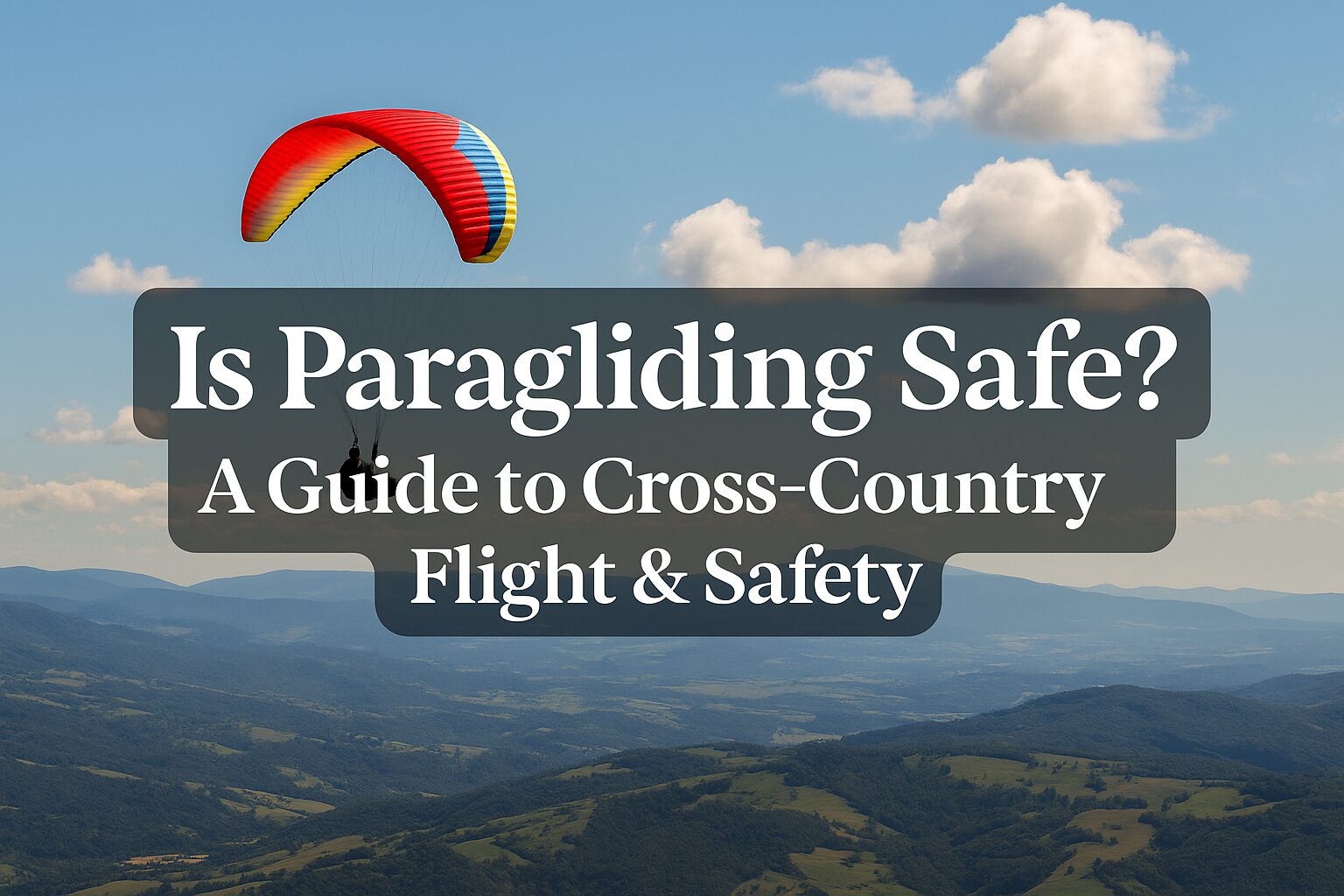Paragliding is one of the most awe-inspiring aerial sports in the world. It’s a dance with the wind, a game of thermals, and a test of both physical endurance and mental clarity. But many aspiring pilots and adventurers still ask: What is paragliding exactly? And more importantly, is paragliding safe, especially when flying across long distances?
In this guide, we’ll answer those questions and more—covering safety, gear, flight duration, and the essentials of cross-country paragliding.
What Is Paragliding?
Let’s start with the basics: paragliding meaning and paragliding definition.
Paragliding is a recreational and competitive sport where a person flies a lightweight, foot-launched glider aircraft. The pilot sits in a harness suspended below a fabric wing composed of a large number of interconnected cells.
Unlike skydiving or hang gliding, paragliding flights can last hours and span hundreds of kilometers—depending on wind, skill, and weather conditions.
Also known as paragl or paraglide, it provides unmatched access to nature from a bird’s-eye view, relying entirely on wind currents and thermals for lift.
What Is Cross-Country Paragliding?
If you’re wondering, what is cross-country flying in paragliding, here’s the short answer: it’s the art of flying long distances from one place to another—often across valleys, ridgelines, or even continents.
Cross-country flying definition:
Flying outside a predefined area using thermal lift and other natural elements to maintain altitude and cover long distances.
This isn’t casual gliding. It involves navigation, endurance, and advanced flying techniques like:
- Thermalling: Finding and circling in rising warm air
- Speed-bar usage: For flying into wind
- Soaring: Using ridges or mountains to gain lift
Cross-country paragliding requires more skill and decision-making than local site flying and is often the ultimate goal for many seasoned pilots.
How Long Do Paragliding Flights Last?
A common question is: What is a paragliding flight duration?
Flight times vary dramatically:
- Beginner flights: 10–30 minutes
- Intermediate flights: 1–3 hours
- Cross-country flights: 4+ hours (some last up to 10 hours)
The duration depends on:
- Weather and thermal activity
- Pilot experience
- Equipment quality
- Terrain and altitude at launch
How Safe Is Paragliding?
One of the biggest concerns for new pilots is: how dangerous is paragliding? Or put another way, how safe is paragliding?
Like any adventure sport, paragliding carries risks, but many of them are manageable with training, good decisions, and proper gear.
Common Risks:
- Wing collapses due to turbulence
- Mid-air collisions with birds or other gliders
- Poor landing zones in remote terrain
- Rapid weather changes
- Pilot error due to poor decision-making
✅ Risk Reduction Tips:
- Train with certified instructors
- Always check weather conditions
- Fly conservatively and avoid crowded skies
- Use certified, modern gear
- Always carry a reserve parachute and radio
In fact, many experienced pilots believe paragliding becomes much safer once you learn to respect the weather and fly within your limits.
Essential Gear for Safe Paragliding
If you’re thinking about trying it, here’s what you’ll need:
- Paraglider Wing: Choose one suitable for your skill level
- Harness: Offers comfort and back protection
- Reserve Parachute: Essential for emergencies
- Helmet: Mandatory for protection
- Variometer: Helps detect lift (thermals)
- GPS & Radio: For navigation and communication
- Flight Suit & Gloves: Useful for long or cold flights
Optional extras include camping gear for vol-bivouac (fly-camping) adventures and trackers for emergency location sharing.
Ideal Conditions for Cross-Country Paragliding
You might ask: Where can I paraglide? or Where can you paraglide?
The answer is: anywhere that offers good launch sites, thermals, and landing areas. But instead of listing specific countries, let’s focus on what makes a location great for cross-country paragliding:
✅ Key Features of Good Flying Sites:
- Consistent thermal activity
- Wide and open landing zones
- Varied topography for dynamic flying
- Predictable and calm wind conditions
- Accessibility and pilot-friendly terrain
These factors matter more than geography. Whether you’re in the mountains, on a plateau, or near coastal cliffs, any area that meets these conditions can support rewarding and safe cross-country flights.
What Does Cross-Country Paragliding Cost?
Understanding the cross-country flight cost is vital if you’re planning to invest.
Equipment Costs:
- Wing: $2,500–$4,500
- Harness + Reserve: $1,000–$2,000
- Helmet, Variometer, Radio: $500–$1,000
- Total Setup: Around $4,000–$7,000
Training Costs:
- Beginner Lessons: $800–$1,500
- Certifications (if required): Additional costs for progression
Travel and Miscellaneous:
- Accommodation, transport to launch sites
- Optional guides or retrieval drivers
- Rescue coverage or evacuation plans for remote areas
Do You Need Rescue or Insurance?
Most standard insurance policies don’t cover paragliding unless explicitly included. If you’re flying cross-country or in remote areas, consider:
- Adventure sports travel insurance
- Medical evacuation coverage
- Tracking devices for emergency location
This ensures you’re not left stranded or without help in case of an accident or weather emergency.
Is Paragliding the Right Adventure for You?
If you value:
- Being immersed in nature
- A mix of freedom and technical skill
- A challenge that sharpens your focus
- An activity that rewards patience and planning
Then yes—paragliding is for you.
Even if the idea of flying solo seems daunting now, you can start with tandem flights, progress through courses, and slowly build up to longer cross-country paragliding days.
Final Thoughts
So, what’s paragliding all about? At its core, it’s a way to experience the sky like never before—guided by nature and your own skill.
- Respect the elements
- Never stop learning
- Use the right gear
- Fly with awareness
Cross-country flights are a pinnacle experience in the sport. They’re not just about distance, but about growth, confidence, and insight.
As your skills grow, so will your flight paths—and your perspective.
And when you’re ready to take the leap and truly understand the sky, let your journey be guided by The Inspiring Insight.




